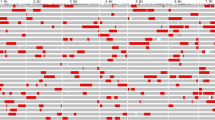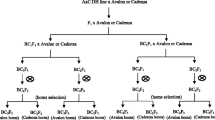Abstract
This paper reports on the first comparative advanced backcross quantitative trait locus (AB-QTL) study in barley. The BC2F2 population H×101 was generated from crossing var. Harry [H; Hordeum vulgare ssp. vulgare (Hv)] with ISR101-23 [101; H. v. ssp. spontaneum (Hsp)]. The results of the AB-QTL analysis for 13 quantitative traits are presented and, subsequently, compared with the AB-QTL study of the barley cross Apex × ISR101-23 (A×101; Pillen et al., Theor Appl Genet 107:340–352). Both AB populations share the exotic Hsp donor accession ISR101-23. In H×101, 108 putative QTLs (17%) were identified among the 650 marker×trait combinations tested. Altogether 52 (48 %) favorable effects were identified from the exotic parent. At these marker loci, the homozygous Hsp genotype was associated with an improvement in the trait compared to the homozygous Hv genotype. The percentage of QTLs detected in H×101 was comparable to that in A×101 (17% vs. 15%), however more favorable exotic QTL alleles were located in H×101 than in A×101 (48% vs. 34%). In H×101, the Hsp QTL allele at EBmac0679[4H] was associated with a yield increase of 5.9% averaged across the six environments tested. A comparison of putative QTLs between H×101 and A×101 was based on 26 shared SSR markers. In total, 26% of the putative QTLs could be detected simultaneously in both AB populations. This finding indicates that only a portion of the QTL effects of the donor allele can be transferred from one elite recipient to the next.
Similar content being viewed by others
References
Backes G, Graner A, Foroughi Wehr B, Fischbeck G, Wenzel G, Jahoor A (1995) Localization of quantitative trait loci (QTL) for agronomic important characters by the use of a RFLP map in barley (Hordeum vulgare L.). Theor Appl Genet 90:294–302
Baumer M, Cais R (2000) Abstammung der Gerstensorten. Bayerische Landesanstalt für Bodenkultur und Pflanzenbau
Bernacchi D, Beck Bunn T, Eshed Y, Lopez. J, Petiard V, Uhlig J, Zamir D, Tanksley S (1998a) Advanced backcross QTL analysis in tomato. I. Identification of QTLs for traits of agronomic importance from Lycopersicon hirsutum. Theor Appl Genet 97:381-397
Bernacchi D, Beck Bunn T, Emmatty D, Eshed Y, Inai S, Lopez J, Petiard V, Sayama H, Uhlig J, Zamir D, Tanksley S (1998b) Advanced backcross QTL analysis of tomato. II. Evaluation of near-isogenic lines carrying single-donor introgressions for desirable wild QTL-alleles derived from Lycopersicon hirsutum and L. pimpinellifolium. Theor Appl Genet 97:170–180
Brondani C, Rangel PHN, Brondani RPV, Ferreira ME (2002) QTL mapping and introgression of yield-related traits from Oryza glumaepatula to cultivated rice (Oryza sativa) using microsatellite markers. Theor Appl Genet 104:1192–1203
Frary A, Nesbitt TC, Frary A, Grandillo S, van der Knaap E, Cong B, Liu J, Meller J, Elber R, Alpert KB, Tanksley SD (2000) fw2.2: a quantitative trait locus key to the evolution of tomato fruit size. Science 289:85–88
Fulton TM, Beck Bunn T, Emmatty D, Eshed Y, Lopez J, Petiard V, Uhlig J, Zamir D, Tanksley SD (1997) QTL analysis of an advanced backcross of Lycopersicon peruvianum to the cultivated tomato and comparisons with QTLs found in other wild species. Theor Appl Genet 95:881–894
Fulton TM, Grandillo S, Beck Bunn T, Fridman E, Frampton A, Lopez J, Petiard V, Uhlig J, Zamir D, Tanksley SD (2000) Advanced backcross QTL analysis of a Lycopersicon esculentum × Lycopersicon parviflorum cross. Theor Appl Genet 100:1025–1042
Fulton TM, Bucheli P, Voirol E, Lopez J, Petiard V, Tanksley SD (2002) Quantitative trait loci (QTL) affecting sugars, organic acids and other biochemical properties possibly contributing to flavor, identified in four advanced backcross populations of tomato. Euphytica 127:163–177
Hackett CA, Ellis RP, Forster BP, McNicol JW, Macaulay M (1992) Statistical analysis of a linkage experiment in barley involving quantitative trait loci for height and ear-emergence time and two genetic markers on chromosome 4. Theor Appl Genet 85:120–126
Hayes PM, Liu BH, Knapp SJ, Chen F, Jones B, Blake T, Franckowiak J, Rasmusson D, Sorrells M, Ullrich SE, Wesenberg D, Kleinhofs A (1993) Quantitative trait locus effects and environmental interaction in a sample of North American barley germplasm. Theor Appl Genet 87:392–401
Hayes P, Prehn D, Vivar H, Blake T, Comeau A, Henry I, Johnston M, Jones B, Steffenson B, St. Pierre CA, Chen F (1996) Multiple disease resistance loci and their relationship to agronomic and quality loci in a spring barley population. J Agric Genomics (http://www.ncgr.org/research/jag/papers96/paper296/ indexp296.html)
Ho JC, McCouch SR, Smith ME (2002) Improvement of hybrid yield by advanced backcross QTL analysis in elite maize. Theor Appl Genet 105:440–448
Huang XQ, Cöster H, Ganal MW, Röder MS (2003) Advanced backcross QTL analysis for the identification of quantitative trait loci alleles from wild relatives of wheat (Triticum aestivum L.). Theor Appl Genet 106:1379–1389
Laurie DA, Pratchett N, Bezant JH, Snape JW (1995) RFLP mapping of five major genes and eight quantitative trait loci controlling flowering time in a winter × spring barley (Hordeum vulgare L.) cross. Genome 38:575–585
Marquez-Cedillo LA, Hayes PM, Jones BL, Kleinhofs A, Legge WG, Rossnagel BG, Sato K, Ullrich SE, Wesenberg DM (2000) QTL analysis of malting quality in barley based on the doubled-haploid progeny of two elite North American varieties representing different germplasm groups. Theor Appl Genet 101:173–184
Marquez-Cedillo LA, Hayes PM, Kleinhofs A, Legge WG, Rossnagel BG, Sato K, Ullrich SE, Wesenberg DM (2001) QTL analysis of agronomic traits in barley based on the doubled-haploid progeny of two elite North American varieties representing different germplasm groups. Theor Appl Genet 103:625–637
Mather DE, Tinker NA, LaBerge DE, Edney M, Jones BL, Rossnagel BG, Legge WG, Briggs KG, Irvine RB, Falk DE, Kasha KJ (1997) Regions of the genome that affect grain and malt quality in a North American two-row barley cross. Crop Sci 37:544–554
Moncada PP, Martínez CP, Borrero J, Chatel M, Gauch H Jr, Guimaraes E, Tohme J, McCouch SR (2001) Quantitative trait loci for yield and yield components in an Oryza sativa × Oryza rufipogon BC2F2 population evaluated in an upland environment Theor Appl Genet 102:41–52
Monforte AJ, Tanksley SD (2000) Fine mapping of a quantitative trait locus (QTL) from Lycopersicon hirsutum chromosome 1 affecting fruit characteristics and agronomic traits: Breaking linkage among QTLs affecting different traits and dissection of heterosis for yield. Theor Appl Genet 100:471–479
Monforte AJ, Friedman E, Zamir D, Tanksley SD (2001) Comparison of a set of allelic QTL-NILs for chromosome 4 of tomato: Deductions about natural variation and implications for germplasm utilization. Theor Appl Genet 102:572–590
Pena de la RC, Smith KP, Capettini F, Muehlbauer GJ, Gallo Meagher M, Dill Macky R, Somers DA, Rasmusson DC (1999) Quantitative trait loci associated with resistance to Fusarium head blight and kernel discoloration in barley. Theor Appl Genet 99:561–569
Pillen K, Binder A, KreuzkamB, Ramsay L, Waugh R, Förster J, Léon J (2000) Mapping new EMBL-derived barley microsatellites and their use to differentiate German barley cultivars. Theor Appl Genet 101:652–660
Pillen K, Zacharias A, Leon J (2003) Advanced backcross QTL analysis in barley (Hordeum vulgare L.). Theor Appl Genet 107:340–352
Ramsay L, Macaulay M, degli Ivanissevich S, MacLean K, Cardle L, Fuller J, Edwards KJ, Tuvesson S, Morgante M, Massari A, Maestri E, Marmiroli N, Sjakste T, Ganal M, Powell W, Waugh R (2000) A simple sequence repeat-based linkage map of barley. Genetics 156:1997–2005
SAS Institute (1999) The SAS system for Windows, release 8.00. SAS Institute, Cary, N.C.
Tanksley SD, McCouch SR (1997) Seed banks and molecular maps: Unlocking genetic potential from the wild. Science 277:1063–1066
Tanksley SD, Nelson JC (1996) Advanced backcross QTL analysis: A method for the simultaneous discovery and transfer of valuable QTLs from unadapted germplasm into elite breeding lines. Theor Appl Genet 92:191–203
Tanksley SD, Grandillo S, Fulton TM, Zamir D, Eshed Y, Petiard V, Lopez J, Beck-Bunn T (1996) Advanced backcross QTL analysis in a cross between an elite processing line of tomato and its wild relative L. pimpinellifolium. Theor Appl Genet 92:213–224
Thomas WTB, Powell W, Waugh R, Chalmers KJ, Barua UM, Jack P, Lea V, Forster BP, Swanston JS, Ellis RP, Hanson PR, Lance RCM (1995) Detection of quantitative trait loci for agronomic, yield, grain and disease characters in spring barley (Hordeum vulgare L.). Theor Appl Genet 91:1037–1047
Tinker NA, Mather DE, Rossnagel BG, Kasha KJ, Kleinhofs A, Hayes PM, Falk DE, Ferguson T, Shugar LP, Legge WG, Irvine RB, Choo TM, Briggs KG, Ullrich SE, Franckowiak JD, Blake TK, Graf RJ, Dofing SM, Saghai Maroof MA, Scoles GJ, Hoffman D, Dahleen LS, Kilian A, Chen F, Biyashev RM, Kudrna DA, Steffenson BJ (1996) Regions of the genome that affect agronomic performance in two-row barley. Crop Sci 36:1053–1062
Xiao J, Grandillo S, Ahn SN, McCouch SR, Tanksley SD, Li J, Yuan L (1996) Genes from wild rice improve yield. Nature 384:223–224
Xiao J, Li J, Grandillo S, Ahn S, Yuan L, Tanksley SD, McCouch SR (1998) Identification of trait-improving quantitative trait loci alleles from a wild rice relative, Oryza rufipogon. Genetics 150:899–909
Zhu H, Gilchrist L, Hayes P, Kleinhofs A, Kudrna D, Liu Z, Prom L, Steffenson B, Toojinda T, Vivar H (1999) Does function follow form? Principal QTLs for Fusarium head blight (FHB) resistance are coincident with QTLs for inflorescence traits and plant height in a doubled-haploid population of barley. Theor Appl Genet 99:1221–1232
Acknowledgements
We wish to thank Dr. Eberhard Laubach and Dr. Volker Lein and their teams for conducting field experiments and collecting trait data at the breeding companies Nordsaat and Ackermann, respectively. We also thank Dr. Lizzy Kuntze and her team for measuring quality traits at the Nordsaat laboratory. In addition, the excellent technical assistance of Karola Müller and the technical team of our experimental station Dikopshof at Wesseling is appreciated. We are indebted to Prof. G. Fischbeck, Technical University, München, for providing the wild barley accession ISR101-23. This work was supported by grants Pi339/1-1 and Pi339/1-2 from the Deutsche Forschungsgemeinschaft (DFG).
Author information
Authors and Affiliations
Corresponding author
Additional information
Communicated by G. Wenzel
This work is dedicated to the 65th birthday of Prof. Dr. H.H. Geiger, Department of Plant Breeding, Seed Science and Population Genetics, University of Hohenheim, Germany.
Rights and permissions
About this article
Cite this article
Pillen, K., Zacharias, A. & Léon, J. Comparative AB-QTL analysis in barley using a single exotic donor of Hordeum vulgare ssp. spontaneum.. Theor Appl Genet 108, 1591–1601 (2004). https://doi.org/10.1007/s00122-004-1586-z
Received:
Accepted:
Published:
Issue Date:
DOI: https://doi.org/10.1007/s00122-004-1586-z




